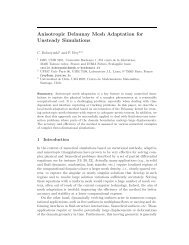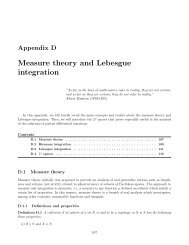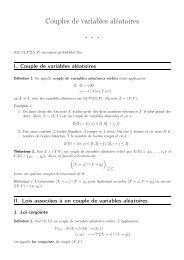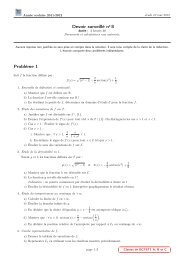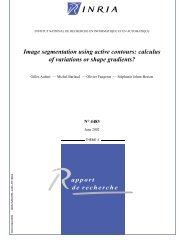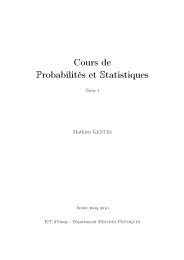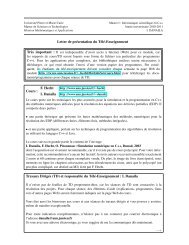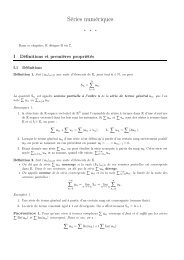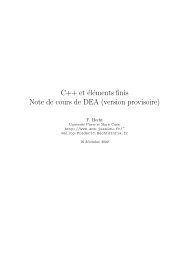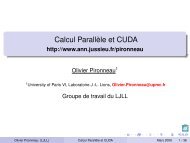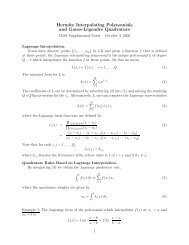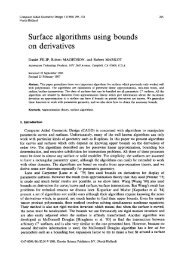Popinet S., Free computational fluid dynamics.pdf
Popinet S., Free computational fluid dynamics.pdf
Popinet S., Free computational fluid dynamics.pdf
You also want an ePaper? Increase the reach of your titles
YUMPU automatically turns print PDFs into web optimized ePapers that Google loves.
stand-alone visualization tool. It is also very powerful.<br />
Gerris comes with a special OpenDX module that<br />
can be used to import simulation files directly into<br />
OpenDX. To use it, start OpenDX like this:<br />
$ dx -mdf /usr/local/lib/gerris/dx2D.mdf<br />
If you are not familiar with OpenDX you should then<br />
read the extensive documentation.<br />
Parallel Computation<br />
Gerris was designed from scratch with parallel computation<br />
in mind. I chose a simple domain decomposition<br />
approach, which is one of the main reason of the<br />
slightly weird graph structure of the domain definition<br />
in parameter files.<br />
Let’s come back to our 2D example. Suppose you<br />
want to use 8 processors of your parallel machine. For<br />
the domain we have, a fairly obvious decomposition<br />
strategy is just to assign each of the eight GfsBox to<br />
each processor. �is can be done easily by modifying<br />
the parameter file like this:<br />
...<br />
GfsBox { pid = 0 }<br />
GfsBox { pid = 1 }<br />
GfsBox { pid = 2 }<br />
GfsBox { pid = 3 }<br />
GfsBox { pid = 4 }<br />
GfsBox { pid = 5 }<br />
GfsBox { pid = 6 }<br />
GfsBox { pid = 7 }<br />
...<br />
�e simulation can then be ran on eight processors like<br />
this:<br />
$ mpirun -np 8 gerris2D cylinder.sim<br />
�e simulation file can still be run on a single processor<br />
as usual (the pid info is just ignored).<br />
What is currently lacking is a parallel output capability.<br />
�e files written by each processor are entirely<br />
independent (i.e. they represent only the part of the<br />
domain simulated by this processor). It is then up to<br />
you to put the puzzle back together.<br />
What we did is an example of manually partitioning<br />
the domain. In more complex cases, Gerris can also<br />
automatically partition the domain for a given number<br />
of processors, variable resolution, complex boundaries<br />
etc. It does this using sophisticated I<br />
algorithms which aim to minimize the cost of<br />
Resources<br />
COMPUTATIONAL FLUID DYNAMICS<br />
Gerris: gfs.sf.net<br />
GTS: gts.sf.net<br />
Glib: www.gtk.org<br />
Mouse: www.vug.uni-duisburg.de/MOUSE<br />
Triangulated mesh of a cylinder:<br />
gfs.sourceforge.net/clusterworld<br />
OpenDX: www.opendx.org<br />
Mayavi: mayavi.sf.net<br />
Geomview: www.geomview.org<br />
ImageMagick: www.imagemagick.org<br />
MJPEG Tools: mjpeg.sf.net<br />
communications between sub-domains. �is is done in<br />
two steps. Let’s say we want to now run our simulation<br />
on 32 processors. Just type:<br />
$ gerris2D -p 5 cylinder.sim > cylinder-32.sim<br />
�is will create a new simulation file which can the be<br />
run on 32 processors. �e -p option is the power of two<br />
processors, in this case two to the fifth power.<br />
Apart from parallel outputs, the main issue which<br />
is not currently addressed by Gerris is dynamic loadbalancing<br />
which is necessary to keep good parallel efficiency<br />
when adaptive mesh refinement is used.<br />
The Future of Gerris<br />
As you have probably found out by now, while Gerris<br />
seems to be on the right track there is still a lot to be<br />
done to take full advantage of its flexibility. Together<br />
with collaborators at NIWA and elsewhere, I am currently<br />
working on several aspects of the code. �e first shortterm<br />
goal is to extend the Navier-Stokes and diffusion<br />
equations solution to three dimensions. �is is made<br />
slightly more difficult by the treatment of embedded<br />
Dirichlet boundary conditions in three-dimensions.<br />
Another active area is the development of non-newtonian<br />
viscous stresses (i.e. <strong>fluid</strong>s for which the stress/<br />
strain relationship is not linear): applications include<br />
the numerical simulation of visco-plastic <strong>fluid</strong>s (e.g.<br />
snow and mud avalanches, granular materials, plastics)<br />
and Large-Eddy-Simulations (LES) turbulence modeling.<br />
A very recent endeavor has been the extension of<br />
Gerris to geophysical <strong>fluid</strong> <strong>dynamics</strong> i.e. oceanic and<br />
atmospheric flows, where the adaptive mesh approach<br />
has proved extremely useful.<br />
Potential extensions which would make full use<br />
of the existing framework are numerous. Just a few<br />
ideas including; steady-state flow solvers, compressible<br />
volume 2 no 6 CLUSTERWORLD 7



